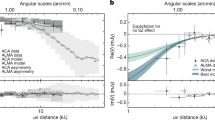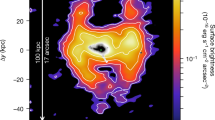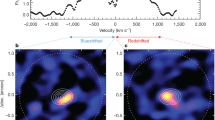Abstract
Little is known about the origins of globular clusters, which contain hundreds of thousands of stars in a volume only a few light years across. Radiation pressure and winds from luminous young stars should disperse the star-forming gas and disrupt the formation of the cluster. Globular clusters in our Galaxy cannot provide answers; they are billions of years old. Here we report the measurement of infrared hydrogen recombination lines from a young, forming super star cluster in the dwarf galaxy NGC5253. The lines arise in gas heated by a cluster of about one million stars, including 4,000–6,000 massive, hot ‘O’ stars1,2. It is so young that it is still enshrouded in gas and dust, hidden from optical view1,3,4,5. The gases within the cluster seem bound by gravity, which may explain why the windy and luminous O stars have not yet blown away those gases. Young clusters in ‘starbursting’ galaxies in the local and distant Universe may also be gravitationally confined and cloaked from view.
This is a preview of subscription content, access via your institution
Access options
Subscribe to this journal
Receive 51 print issues and online access
$199.00 per year
only $3.90 per issue
Buy this article
- Purchase on Springer Link
- Instant access to full article PDF
Prices may be subject to local taxes which are calculated during checkout



Similar content being viewed by others
References
Turner, J. L., Beck, S. C. & Ho, P. T. P. The radio supernebula in NGC5253. Astrophys. J. 532, L109–L112 (2000)
Meier, D. S., Turner, J. L. & Beck, S. C. Molecular gas and star formation in NGC5253 revisited. Astron. J. 124, 877–885 (2002)
Beck, S. C., Turner, J. L., Ho, P. T. P., Kelly, D. & Lacy, J. H. The central star cluster of the star-forming dwarf galaxy NGC5253. Astrophys. J. 457, 610–615 (1996)
Turner, J. L., Ho, P. T. P. & Beck, S. C. The radio properties of NGC5253 and its unusual HII regions. Astron. J. 116, 1212–1220 (1998)
Gorjian, V., Turner, J. L. & Beck, S. C. Infrared emission from the radio supernebula in NGC5253: A proto-globular cluster? Astrophys. J. 554, L29–L32 (2001)
Caldwell, N. & Phillips, M. M. Star formation in NGC5253. Astrophys. J. 338, 789–803 (1989)
Gorjian, V. WFPC2 imaging of the starburst galaxy NGC5253. Astron. J. 1120, 1886–1893 (1996)
Calzetti, D. et al. Dust and recent star formation in the core of NGC5253. Astron. J. 114, 1834–1849 (1997)
Tremonti, C. A., Calzetti, D., Leitherer, C. & Heckman, T. M. Star formation in the field and clusters of NGC5253. Astrophys. J. 555, 322–337 (2001)
McLean, I. S. et al. Performance and results with the NIRSPEC echelle spectrograph on the Keck II Telescope. Proc. SPIE 4008, 1048–1055 (2000)
Kawara, K., Nishida, M. & Phillips, M. M. Brackett alpha and gamma observations of starburst and Seyfert galaxies. Astrophys. J. 337, 230–235 (1989)
Storey, P. J. & Hummer, D. G. Recombination line intensities for hydrogenic atoms. IV. Total recombination coefficients and machine-readable tables for Z = 1 to 8. Mon. Not. R. Astron. Soc. 272, 41–48 (1995)
Walsh, J. R. & Roy, J.-R. Optical spectroscopic and abundance mapping of the amorphous galaxy NGC5253. Mon. Not. R. Astron. Soc. 239, 297–324 (1989)
Rieke, G. H. & Lebofsky, M. J. The interstellar extinction law for 1 to 13 microns. Astrophys. J. 288, 618–621 (1985)
Mohan, N. R., Anantharamaiah, K. R. & Goss, W. M. Very Large Array observations of the H92α line from NGC5253 and Henize 2–10: Ionized gas around super star clusters. Astrophys. J. 557, 659–670 (2001)
Martin, C. L. & Kennicutt, R. C. Jr Soft X-ray emission from NGC5253 and the ionized interstellar medium. Astrophys. J. 447, 171–183 (1995)
De Pree, C. G., Wilner, D. J., Goss, W. M., Welch, W. J. & McGrath, E. Ultracompact HII regions in W49N at 500 AU scales: Shells, winds, and the water maser source. Astrophys. J. 540, 308–315 (2000)
Chu, Y. H. Ring nebulae around massive stars throughout the HR diagram. In IAU Symposium 212 (eds van der Hucht, K. A., Herrero, A. & Esteban, C.) (in the press)
Wood, D. O. S. & Churchwell, E. Massive stars embedded in molecular clouds: Their population and distribution in the Galaxy. Astrophys. J. 340, 265–272 (1989)
Kunth, D. et al. HST study of Lyman-alpha emission in star-forming galaxies: the effect of neutral gas flows. Astron. Astrophys. 334, 11–20 (1998)
Tenorio-Tagle, G., Silich, S. A., Kunth, D., Terlevich, E. & Terlevich, R. The evolution of superbubbles and the detection of Lya in star-forming galaxies. Mon. Not. R. Astron. Soc. 309, 332–342 (1999)
Meier, D. L. & Terlevich, R. Extragalactic HII regions in the UV. Implications for primeval galaxies. Astrophys. J. 246, L109–L113 (1981)
Hartmann, L., Huchra, J. P. & Geller, M. J. How to find galaxies at high redshift. Astrophys. J. 287, 487–491 (1984)
Steidel, C. C., Giavalisco, M., Pettini, M., Dickinson, M. & Adelberger, K. L. Spectroscopic confirmation of a population of normal star-forming galaxies at redshifts z > 3. Astrophys. J. 462, L17–L21 (1996)
Walborn, N. R. & Barbá, R. H. in New Views of the Magellanic Clouds (eds Chu, Y.-H., Suntzeff, N., Hesser, J. & Bohlender, D.) 213 (Astronomical Society of the Pacific, San Francisco, 1999)
Mills, B. Y., Turtle, A. J. & Watkinson, A. A radio model of the 30 Doradus region. Mon. Not. R. Astron. Soc. 185, 263–276 (1978)
Kennicutt, R. C. Jr & Chu, Y.-H. Giant HII regions and the rormation of populous clusters. Astron. J. 95, 720–730 (1988)
Melnick, J., Tenorio-Tagle, G. & Terlevich, R. Supersonic gas motion in extragalactic HII regions. Mon. Not. R. Astron. Soc. 302, 677–683 (1999)
Moorwood, A. F. M. & Glass, I. S. Infrared emission and star formation in NGC5253. Astron. Astrophys. 115, 84–89 (1982)
Acknowledgements
We thank T. Glassman and E. Greisen for assistance with the data and M. Jura for discussions. This research is supported by the US National Science Foundation, the Israel Academy Center for Multi-Wavelength Astronomy, and the Laboratory of Astronomical Imaging at the University of Illinois.
Author information
Authors and Affiliations
Corresponding author
Ethics declarations
Competing interests
The authors declare that they have no competing financial interests.
Rights and permissions
About this article
Cite this article
Turner, J., Beck, S., Crosthwaite, L. et al. An extragalactic supernebula confined by gravity. Nature 423, 621–623 (2003). https://doi.org/10.1038/nature01689
Received:
Accepted:
Issue Date:
DOI: https://doi.org/10.1038/nature01689
This article is cited by
-
Highly efficient star formation in NGC 5253 possibly from stream-fed accretion
Nature (2015)
-
2D hydrodynamic simulations of super star cluster winds in a bimodal regime
Astrophysics and Space Science (2009)
Comments
By submitting a comment you agree to abide by our Terms and Community Guidelines. If you find something abusive or that does not comply with our terms or guidelines please flag it as inappropriate.



